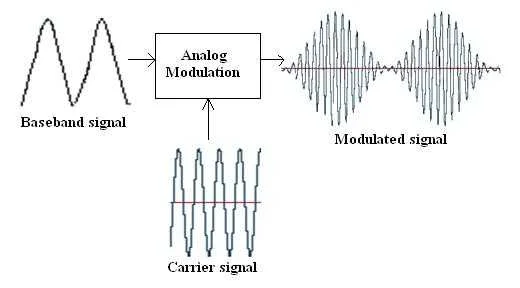What is modulation | Functions, applications, modulation types
This page describes modulation basics including what is modulation, its applications, modulation functions and modulation types.
Introduction:
Modulation is a term widely used in telecommunication or wireless networks.
Modulation basically is used to convert information (digital bit stream or analog audio signal)
in the form that can be physically transmitted over the air or cable.
Information is referred as baseband or modulating signal. The waveform which is used to convert the
information in the physically transmitted form is called carrier.
The device which performs modulation operation is called modulator and the resulting waveform or output of modulator is called as modulated signal. The device which performs inverse of modulation is called demodulator and the operation is named as demodulation. The device which does both modulation and demodulation is called MODEM.
Modulation can be applied on Direct current, alternating current and optical signal. Earlier days Morse code has been used in telegraphy which was used as modulation technique to convert information into the form that can be transmitted over telegraph line. It is used to convert information to binary form i.e. ON and OFF forms. This is very popular in amateur radio.
The live example of modulation and demodulation process is in our home when we use internet. For Internet we use MODEM which can housed in USB Dongle, Mobile, IPAD, laptop etc. In MODEM, modulator converts digital information into analog audio tones (or Radio frequency signal) and demodulator does reverse.
Modulation Functions
Following are the main functions of modulation techniques.
• It is used to convert digital information into analog form suitable to be
transported between two points in a wired/wireless system.
• It helps to cover longer distances with smaller antenna types for
signals to be propagated in the Earth's atmosphere. With modulation, antenna sizes are practically achievable.
• The modulation techniques such as QPSK, 16QAM, 64QAM, 256QAM helps to
achieve higher data rate as they maps more number of bits over single carrier frequency signal.
• Angle modulation techniques helps to reduce noise and to improve system fidelity.
• ASK offers high bandwidth efficiency. FSK offers higher SNR. PSK offers susceptibility against errors.
Modulation Applications
Following are the applications of modulation types.
• Low speed, Voice band based data communication modems
• High speed, data transmission systems
• Satellite communication systems and digital microwave systems
• GSM, LTE (4G), WiMAX, WLAN, 5G technologies
• FM radio broadcast, TV sound signal, 2-way mobile radio etc.
Modulation types
To know what is modulation, let us understand two major categories of modulation. Analog modulation and digital modulation, the same is depicted in following figure. AM has been shown for analog modulation and ASK for digital modulation. The fundamental difference is, baseband input signal for Analog modulation is analog and for digital modulation it is digital. The carrier is analog for both the cases.


Analog modulations techniques are as follows
AM: The carrier amplitude is changed as per analog baseband signal.
FM: The carrier frequency is changed as per analog baseband signal.
PM: The carrier phase is changed as per analog baseband signal.
Applications: Radio and television broadcast stations use AM and FM form of modulation. Some employ Single Side Band Modulation.
Few of digital modulation techniques are as follows
ASK- It uses a finite number of amplitudes. Widely used in optical fiber where in for LED transmitters binary 1 is by a pulse of light and binary 0 by the absence of light. In some other applications different amplitudes i.e. lower and higher amplitudes are used to represent binary 1 and binary 0.
FSK- It uses a finite number of frequencies. F1 and F2 are used to represent binary 1 and binary 0.
PSK- It uses a finite number of phases. P1 and P2 are used to represent binary 1 and binary 0.
The most complex digital modulation techniques used now-a-days are BPSK, QPSK and QAM, widely employed in radio and microwave communications for cellular and satellite communication.
We have covered modulation basics such as what is modulation, its functions, modulation applications and modulation types viz. analog modulation (AM, FM, PM) and digital modulation (ASK, FSK, PSK). Also refer Analog modulation vs digital modulation >>, ASK vs FSK vs PSK >>, advantages/disadvantages of AM and FM >>, ASK Modulation >>, FSK Modulation >> and PSK Modulation >> for more information.
Modulation MATLAB CODE
BPSK QPSK 16QAM 64QAM modulation matlab code
Modulation types
BPSK-This page describes BPSK modulation technique with equation and constellation diagram.
QPSK -This page describes QPSK modulation technique with equation and constellation diagram.
QAM-This page describes QAM modulation technique with equation and constellation diagram.
MSK-GMSK MSK modulation,GMSK modulation and GMSK demodulation.
8PSK 8-PSK modulation or multilevel PSK or phase shift keying modulation technique.
BPSK vs QPSK -Difference Between BPSK and QPSK modulation techniques.
QPSK vs OQPSK vs pi/4QPSK-Difference between QPSK,OQPSK and pi/4QPSK modulation techniques
Differential Encoder and Decoder
What is?
what is RF? what is wireless ? what is zigbee? what is Bluetooth? what is lightwave RF? what is z-wave? what is microcontroller? what is GSM? what is GPRS? what is infrared?
RF and Wireless Links
RF Terminology Satellite Terminology VSAT system overview FDMA versus TDMA versus CDMA VSAT SCPC VSAT MCPC RF Transceiver basics C band RF Transceiver Design and Development Microstrip basics and types Design of RF frequency converter RF Power Amplifier what is modulation satellite Modem design RF Link Budget
